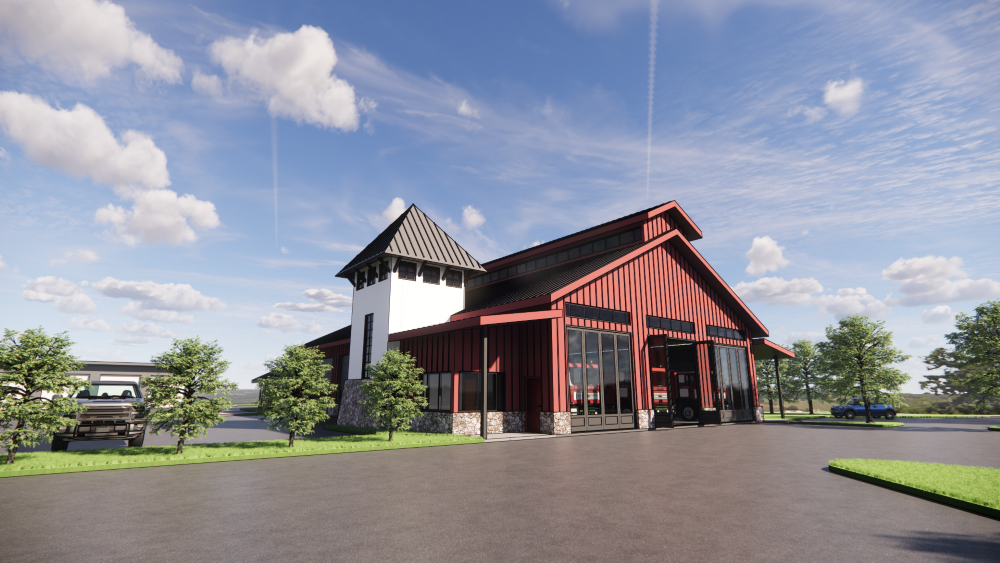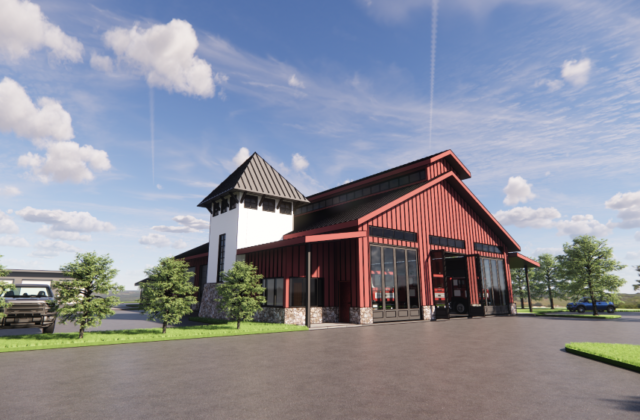New Firehouse Design Gets Scrutiny at P&Z Meeting
Public hearing to continue on Dec. 12
By Joe Kelly
How do you blend a modern, utilitarian, 21st century building into a community that consists primarily of small, wood frame homes that are 100 to 200-plus years old?
If the initial hearing on Norfolk’s new firehouse that took place before the Planning and Zoning (P&Z) Commission last month was any indication, the answer appears to be “not easily.”
Norfolk’s current firehouse on Shepard Road has been deemed too small and unsafe and the firefighters, along with the town, have been working with an architect, David Stein of Silver/Petrucelli and Associates, to design a replacement. The new plan calls for a $5 million facility with enough room for all of the major vehicles plus more space for storage, training, decontamination facilities, better ventilation, offices, an up-to-date commercial kitchen—in short, a facility designed for modern emergency response. It would be built in the same area as the existing firehouse, which would eventually be torn down.
Because the site on Shepard Road includes 8.000 square feet of wetlands, Norfolk’s Inland Wetlands Agency weighed in first and gave its approval in October.
The plans are now before P&Z which is looking at all aspects of the project—architecture, lighting, landscaping, construction process, etc.—and is also having a review done by an outside town planner, Glenn Chalder, president of Planimetrics of Avon. The P&Z’s hearing will resume on Dec. 12 at 6:30 p.m. at Town Hall.

Rendering of new firehouse as it would appear from Shepard Road.
Making a New Building Look Old
From an architectural point of view, the primary challenge is one of scale. Firehouses of yore were essentially wood barns built just big enough to house one or two vehicles the size of farm tractors or small trucks. Today’s fire engines are much bigger, there are more of them and safety regulations mandate that they be surrounded by more space. Making room for all of that is a key reason why the proposed new firehouse is clocking in at 10,000 square feet—more than double the size of the current building.
In an extensive back and forth, the architect and P&Z commissioners explored how different architectural elements can be used to make the new firehouse not seem so out-of-place, including:
Street frontage: While the existing firehouse is squat and square, the new building will be a long and narrow, extending back from Shepard Road to near the City Meadow. The smallest façade—a three bay garage—will face the street, keeping the appearance closer in scale to other buildings in the village area.
Roofline: Peaked/gabled roofs are an instantly recognizable feature of New England/colonial architecture—better to shed rain and snow—and the new firehouse has such a roof with a line of dormered windows. The roof itself will be metal.
Tower: Look around town and you’ll see a lot of towers on Victorian-era houses and other structures in Norfolk—Infinity Hall has one and the Arcanum Building originally had one too. The architects are proposing that the new firehouse have one sheathed in white clapboards with eyebrow windows under the roof. Towers were also a classic part of fire house architecture, used as lookouts, bell towers and for hanging hoses to dry—hose drying will be the purpose for Norfolk’s firehouse tower.
Siding/Color: The primary siding for the new firehouse will be vertical board-and-batten, which also became very popular during the Victorian era. It consists of wide planks (boards) butt joined vertically with thin vertical strips (battens) covering the seams. While traditionally made of wood, to keep ongoing maintenance costs down, the boards and battens of the new firehouse (as well as the clapboards on the tower) are likely to be made of a synthetic material, such as fiber cement, manufactured to mimic the look of wood and purchased pre-painted. (A common commercial example of this is called Hardie board.) The proposed color is currently maroon.
Lighting: As a public building, the firehouse requires basic lighting at all times (e.g., at entrances) as well as more extensive illumination for when the building is in use. The lighting fixtures will be “dark sky” compliant—facing down and inward to minimize glare and light pollution. Concerns over lighting generated more discussion among commissioners than anything else at the P&Z’s hearing.
Plantings: Landscaping around the firehouse and parking lot is expected to include a mix of deciduous trees, conifers/evergreens as well as herbaceous plantings, such as native grasses. Landscaping was mentioned in passing and there was no detailed discussion of specific plantings around the firehouse or how they might be integrated with the surrounding area, including the nearby City Meadow. Three-quarters of an acre from the City Meadow will be transferred for use by the firehouse.
The public is invited to attend the next P&Z hearing on Dec. 12 at 6:30 p.m. at Town Hall or submit comments via email to the zoning enforcement officer at mhalloran@norfolkct.org.

